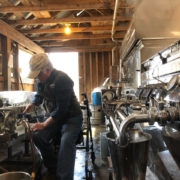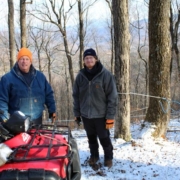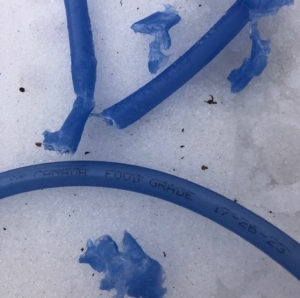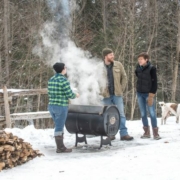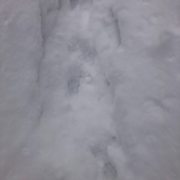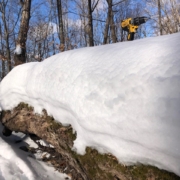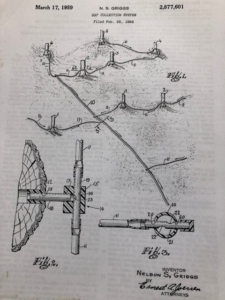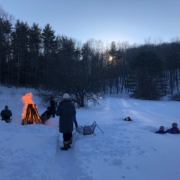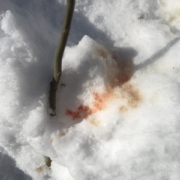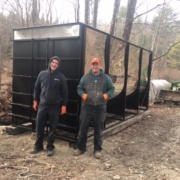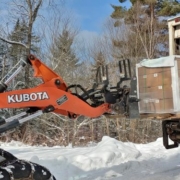When we see the Made in Vermont stamp on an agricultural product, we view it as a badge of quality. We probably know the town where it’s made, and might even know the people who made it. We can assume that it’s produced in relatively small quantities, and can imagine the care that went into its production – something we rarely expect in mass-produced products. The same is true with durable goods, and that’s part of what makes Vermont Evaporator such a cool story. This Made in Vermont item is itself much like the syrup it produces: hand-crafted with pride in small batches.
We caught up with Vermont Evaporator founder Kate Whelley McCabe to find out what goes into making each of company’s flagship Sapling evaporators. She provided this series of photos and walked us through the production process at Vermont Evaporator’s Montpelier headquarters.
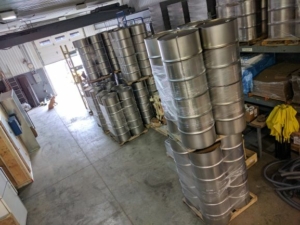
“We special-order new, unpainted and unlined, 55-gallon steel barrels,” Kate explained. Most barrels sold are treated inside and out to protect the metal or the contents being stored. “But we’re not using the barrels to store something; we’re using the barrels to do something,” she noted. She added that most barrels are standardized by volume size rather than height and width; but in order to standardize the manufacturing process (the jigs used, the boxes for shipping, etc.), Vermont Evaporator has to be very careful to be sure they are getting barrels with exactly the same dimensions every time. (Also in the photo: Oliver, the shop dog, guards the door.)
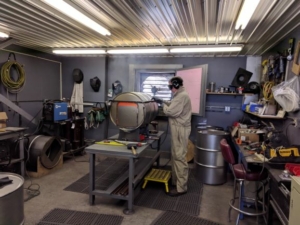
The new barrels are placed in a jig and cut using a plasma cutter; the heat from the process lights up the inside a bright red as the employee makes the cuts. “Behind him is a giant fan that removes the fumes,” said Kate. “And we’re sure that all of our employees wear all of the necessary protective equipment.”
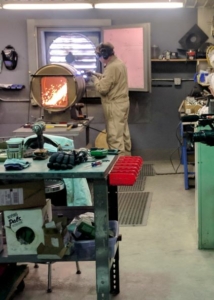
In this photo, the front door of the evaporator has been cut out, and the top opening where the pan will sit is being cut. An opening on the back for the smokestack will also be added.
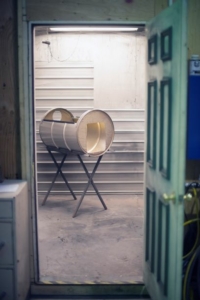
Here, in an artistic shot that Kate said could be called “Portrait of a Barrel,” all of the cuts have been made. A frame to hold the pans has been attached along the sides of the top opening. And now it’s time for the “media blasting” – this essentially sands the barrel to prepare the surface before a coating is applied. “Instead of sand blasting, we use aluminum oxide,” said Kate. The employee dons fully protective PPE, including a helmet/mask with clean air supply hose before entering the blasting room to begin the process.
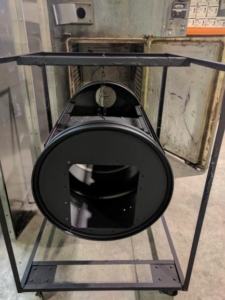
Vermont Evaporator achieves a durable protective coating for its evaporators without using a typical paint. “The wet part of paint is a solvent, and that’s actually the toxic part,” Kate explained. Instead, the company uses a dry particulate [often called a powder coating], which is blown onto the barrel. Here, the soon-to-be evaporator is being removed from the high-temperature oven that “cures” the powder coating.
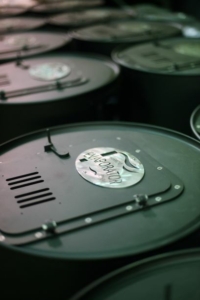
At this point, the pieces all come together. This evaporator, which is sitting up on its back end for assembly, has been outfitted with a door frame and door, as well as the company’s emblem. A vent will be added (the holes for it are already cut).
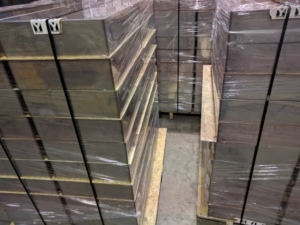
One part of the evaporator that’s not manufactured in Vermont is the stainless steel pan in which sap will be made into syrup. “We sourced everything in Vermont at first, but the company that made the pans unfortunately went out of business,” said Kate. “But we kept in New England – the pans are currently coming from the Springfield, Mass., area.” Vermont Evaporator looked into producing its own pans, but the materials involved require highly specialized equipment and expertise. “Our pans are food-grade stainless steel with lead-free welds. Stainless is a whole different beast; we’re talking about hundreds of thousands of dollars in equipment and highly specialized skills.”
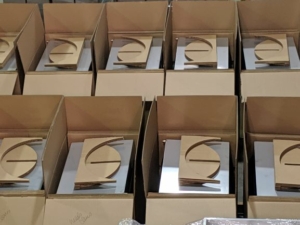
Almost ready: These saplings are boxed and ready to go, with hand-written notes indicating the final pieces needed before shipping. Since Covid, customer pick-ups have been impossible, so all Vermont Evaporators are now shipped; this critical part of the process is expensive and requires careful packing and a lot of attention to detail, said Kate. It’s also another area where the special nature of doing business in Vermont pays off. “UPS is really good at their job. And I’ve built up a good rapport with our driver over the years,” she joked. “I’m talking making him Christmas cookies! We’ve worked out a system where he knows when we have boxes that really need to get out. Personal relationships really help.”

